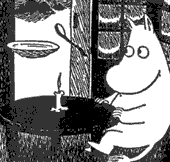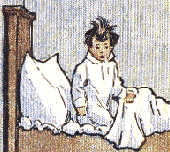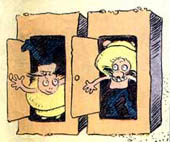>> Triple A: Urban Legend
>> Letter from the Editors
More...

ANDREW WHEELER: We have here Maurice Horn's WORLD ENCYCLOPEDIA OF COMICS, one of the biggest, fattest, heaviest books on comics ever written. And what we're going to do is pick random subjects to discuss by flipping through the pages, picking a subject and seeing if we have anything to say about it. It's a test of our ability to blather meaninglessly without any actual angle.
ALASDAIR WATSON: Do we need this tested?
ANTONY JOHNSTON: I think the previous Triple A's have been evidence enough.
ROB LIEFELD
WHEELER: Ha-ha! "The wunderkind of American comics." What do we have to say about Rob Liefeld?
JOHNSTON: Very little. I'm not especially familiar with his work, ironically.
WHEELER: You have got X-FORCE #1.
JOHNSTON: That was sent to me by a friend precisely so I could read how hilarious it was. Beyond that I don't think I've ever read a Liefeld comic. Seriously.
WHEELER: My memory of Rob Liefeld - I feel like I'm on THIS IS YOUR LIFE - when he first started on NEW MUTANTS, was that there was that hot artist buzz, and I remember looking at his work and thinking this is something new, different... there was a genuine buzz of excitement about his work. But then it sank in that it was rubbish, and then you started to ask, why do all those men have vacuums in their groins? Why don't they have any ankles?
WATSON: I will go so far as to say Liefeld's art is very kinetic. That's where the good bit ends.
WHEELER: And he's got enthusiasm.
''He could more accurately be compared to Madonna than Jack Kirby.'' JOHNSTON: From what I know of Liefeld and his career, he was in the right place at the right time. And he capitalised on it extremely well, made a mint for himself and made his reputation. And yet all the evidence points to his business acumen being appalling, and his talent not being especially strong. But by all accounts he's so enthusiastic and such a nice guy that people actually forgive him.
WHEELER: Maurice Horn writes, "He could more accurately be compared to Madonna than Jack Kirby". That's probably a fair comparison. He's not an artist; he's a marketing gimmick.
JOHNSTON: He's very good at promoting his vision. I don't care for his work, but I've never heard a bad word said about him personally.
BRYAN TALBOT
WATSON: ONE BAD RAT [Bryan Talbot's graphic novel dealing with child abuse and homelessness] is the comic I use to make people understand that this is a medium that has something useful and sensible and worthwhile to say. I know Bryan's been told by a lot of people that ONE BAD RAT has helped people, and purely by my own experience, I know it has. It's helped people I've given it to. It's a really affecting story. One of the few comics I've broken down in floods of tears over. And in terms of craft it's really, really good.
JOHNSTON: It was certainly a surprising work to come from someone who made their name writing surreal hippy head comics.
WATSON: I got the impression from reading his endnotes that ONE BAD RAT was intended to be a very different story, and he thought that perhaps the abused child angle would be a useful one, and then he read about it and thought, this has to be the core of the book.
WHEELER: So nothing controversial to say about him, then?
WATSON: He's just far too talented and a really nice bloke.
WHEELER: Damn.
THE MOOMINS
WHEELER: We have a choice, here. THE MOOMINS or Alan Moore.
WATSON: Let's do THE MOOMINS!
 JOHNSTON: Fantastic children's fiction.
JOHNSTON: Fantastic children's fiction.
WHEELER: Very scary. That's real kids' horror.
JOHNSTON: Proof that kids like to be scared and depressed and afraid. "Winter In Moominland"... God, how I remember that. Was it ever actually explained what they were?
WATSON: They were Moomins!
WHEELER: All it says here is that Moomintroll was a sort-of hippo that walked on two legs and loved something similar called a Snorkmaiden. Moonintroll and Snorkmaiden. One of the great love stories of all time.
WATSON: Romeo and Juliet. Troilus and Cressida. Moomintroll and Snorkmaiden. I can see that.
GUIDO CREPAX
WATSON: Sounds like a communicable disease.
JOHNSTON: European fellow.
WHEELER: Erotic stuff.
WATSON: Communicable disease!
WHEELER: I'm all in favour of European soft-core porn. Why don't we have more stuff like that instead of the demon monster stuff?
WATSON: European porn isn't soft-core.
WHEELER: OK, porn that has an appreciation of actual beauty, is what I'm trying to say.
WATSON: What way up is this picture meant to be?
WHEELER: I think she's humping her handbag. I don't know why.
'Guido Crepax sounds like a communicable disease.' JOHNSTON: You need to read more Serpieri and Manara. Manara's the author of CLICK and GULLIVERA, and Serpieri is the author of DRUUNA, which you must have seen. It's probably the only porn comic that has a woman with a realistic body. As in she's got a huge ass and a stomach.
HOWARD CRUSE
WHEELER: STUCK RUBBER BABY is one of the great comics of recent years. It's very affecting and very well done. His art style may take some getting used to - it's very cartoony - but he's a very skilled storyteller. Very good at communicating emotion and character. I'm also a big fan of WENDEL, which was published in The Advocate for many years, but I only discovered it through the recent collection, ALL TOGETHER. It's a soap opera story about being gay in the 80s, having to deal with AIDS, with Reagan. It hangs together very well as a collection, almost as a graphic novel, even though it's a series of one-page strips.
JOHNSTON: I've read good reviews of STUCK RUBBER BABY. I've also heard people say it's utterly dull.
WATSON: These people are wrong.
WHEELER: Yes, these people are wrong.
ANDY CAPP
JOHNSTON: ANDY CAPP is something I find fascinating, because it ran for so many years, and it hinged on, like, four jokes. It had a tiny cast of characters who always made the same jokes, and I used to wonder if it was generated from templates of some kind, because the draughtsmanship was amazing. Andy Capp, when he was walking, looked exactly the same every single time. My father used to read The Mirror, and I used to get several days' worth of The Mirror and stick the strips of Andy Capp next to one another, and it looked as if it was done with rubber stamps.
WHEELER: Would your parents not let you out of the house? Collecting issues of The Mirror and comparing the strips? Did you not have a bicycle?
JOHNSTON: I was interested in that sort of thing!
LITTLE NEMO IN SLUMBERLAND
WHEELER: You both should be looking at LITTLE NEMO, because it's one of the most beautiful, exquisite works. I have the LITTLE NEMO collection, it didn't cost an awful lot of money, it was about £25 for the complete LITTLE NEMO, and it is some of the most extraordinary artwork.
WATSON: Bring me the heavy tome! Good God! I can barely lift it.
JOHNSTON: It's pastiched an awful lot in PROMETHEA.
WATSON: It turns up in SANDMAN as well.
 WHEELER: Yes. Anyone worth their salt ought to know Winsor McCay. He's one of the fathers of comics, and ought to be recognised as such, even by today's modern, jaded audience.
WHEELER: Yes. Anyone worth their salt ought to know Winsor McCay. He's one of the fathers of comics, and ought to be recognised as such, even by today's modern, jaded audience.
WATSON: I look at the colouring on this and wonder, why can't we get this on all comics back then? Why can't all comics be that lovely?
JOHNSTON: Well, that's watercolours. Not everything can be that lovely.
WHEELER: That's all one-page strips, but there are some prolonged stories in there. It starts out very irritating, because every story ends with the same punchline of Nemo waking up, but as it goes on, although they retain that panel, that's just a pause in the ongoing story. There's a lovely prolonged piece where he's on an airship, travelling through different fantastic lands. Alan Moore's got nothing new...
WATSON: I'm reasonably sure Little Nemo didn't wander around the Sephiroth.
WHEELER: I'm not willing to commit.
WATSON: Didn't you originally buy that as a present for your nephew, or something?
WHEELER: Uh... shhh. Anyway...
AND HER NAME WAS MAUDE
WATSON: Whose was?
JOHNSTON: Maude's.
THE PERISHERS
JOHNSTON: I used to read that. That was The Mirror as well.
WHEELER: I hated THE PERISHERS. Common Northern children.
JOHNSTON: See, this is why I liked it. The strip was very funny.
WHEELER: I always felt it was just a British PEANUTS.
JOHNSTON: Kind of. That's not unfair. But it was very funny. As long as you accepted that that's what the initial concept was based on. There was a Charlie Brown equivalent. Wellington. And the dog was Boot.
WATSON: Was it ever explained why Charlie Brown had no hair?
WHEELER: Perhaps he fell out of the kite eating tree and banged his head?
JOHNSTON: Billy the Whiz didn't have any hair, either.
WHEELER: Well, he ran very fast...
JOHNSTON: And everybody knows your hair falls out when you run very fast.
WATSON: Billy Whiz has a drug named after him. You can draw your own conclusions.
THE UPSIDE DOWNS OF LITTLE LADY LOVEKINS
AND OLD MAN RUFFEROO
 WHEELER: Oh, good lord, I have read this. These are the comics where you read the comic once all the way through, then turn them upside down and read the exact same pictures the other way, and it's a continuation of the same story. The art looks slightly silly; it's a woman with some legs sticking out of her head. There's a woman and a man, and when you turn it upside down they're the other way around. It doesn't really work, but it's a valiant stab at experimental comics, and I'm sure it'll turn up in PROMETHEA eventually.
WHEELER: Oh, good lord, I have read this. These are the comics where you read the comic once all the way through, then turn them upside down and read the exact same pictures the other way, and it's a continuation of the same story. The art looks slightly silly; it's a woman with some legs sticking out of her head. There's a woman and a man, and when you turn it upside down they're the other way around. It doesn't really work, but it's a valiant stab at experimental comics, and I'm sure it'll turn up in PROMETHEA eventually.
THE HILDEBRANDT BROTHERS
WHEELER: "Best known for their work illustrating JRR Tolkien's LORD OF THE RINGS."
WATSON: Are they? I only know them from trading cards.
WHEELER: I don't like them very much, to be honest. I used to like their work, back when I'd not seen many painted comics. Then I realised they're actually kind of like Alex Ross without the wrinkles. And that's not a good thing. They're very plain. They're better than the Vallejos. Boris and Doris.
WATSON: The Vallejos?
WHEELER: They do lots of physique painting.
JOHNSTON: Boris Vallejo's stuff is done from models.
WHEELER: And it still looks awful. There's a book called TITANS, I think that's by Boris Vallejo and Julie Bell. I don't know what happened to Doris. Can you imagine going from being part of the Boris and Doris team to just being Doris on your own?
JOHNSTON: Frank Frazzetta used to paint his wife an awful lot.
WHEELER: I hope she had lots of white sprit.
SERGIO ARAGONES
WHEELER: I used to love GROO. Aragones is a great comedian.
WATSON: It's sad that he won't do sketches anymore. Too many of them end up on eBay, apparently. And that's a shame, because if there's someone I'd want in my sketchbook in the certain knowledge that it'll be distinctive and weird and like nothing else, it would be Aragones.
JOHNSTON: Aragones works better in strip form, for me. His long form comics don't make me laugh as much as the short two panel gags. Or even one panel gags.
WATSON: The thing with GROO for me was that it was as often touching as it was funny.
JOHNSTON: Aragones' humour relies so much on surrealism and absurdity, it often just works better as a quick gag than as part of a longer work.
WHEELER: Maybe. The issues I've read there were some rather nice pastiches of fantasy fiction, and he can tell a good yarn when he wants to.
THE SUBMARINER
WHEELER: One of the classic superheroes, yet of the classic superheroes he's one of the least well used. I mean, even the Human Torch has been in print for decades in another version. Superman is always around, Wonder Woman is always around, Captain America is... coping. But the Submariner can never even hold down his own book. He's one of the great Timely characters.
'How can a member of the royal family of Atlantis not be interesting?' JOHNSTON: Timely in what way? Were there a lot of visitors from Atlantis popping on to America's shores at the end of the Second World War?
WHEELER: Er... no, Timely as in the publisher.
WATSON: I know what his problem is. He's got no logo on his chest.
JOHNSTON: I think the problem is that everyone thinks he's fucking Vulcan.
WHEELER: That's true, and he does wear a swimming costume all the time.
JOHNSTON: I was going to say, so does Aquaman, and he's all right, but no, he's not, is he?
WATSON: And lets be fair, he actually has a superhero costume, not just a swimming costume.
WHEELER: The Sub-Mariner does have scaly underpants! And little wings on his feet.
JOHNSTON: What is he, exactly?
WHEELER: He's prince of Atlantis, and he's half human.
JOHNSTON: So he is Spock, then!
WHEELER: Yes, apart from the stuff about... Atlantis. His mother was an Atlantean princess who fled home and shagged a fisherman.
JOHNSTON: As you do. This was something I was saying about Aquaman the other day. How can a member of the royal family of Atlantis not be interesting?
WHEELER: I have to say, I quite like the Submariner's visual. I don't think that's necessarily the hindrance to the character's success, that he just wears underwear. He's a very regal and distinctive looking character, and he's a great action hero... Hey, he used to be in a comic called YOUNG MEN. That explains so much. I think the problem with him is that he's a pompous git.
JOHNSTON: That's not a problem. Characters shouldn't have to be nice.
WHEELER: No, but he needs the right story to make him a success. He ought to be played off as a nicer Doctor Doom.
WATSON: Does not play well with other characters. He's a character who can be portrayed as an ally or a villain about the same amount of time. Sometimes his interests will conflict with yours and he will have no problem about doing what he has to do. He will not be nice to you unless your interests coincide.
JOHNSTON: The John Constantine of Atlantis, then.
WHEELER: Absolutely!
WATSON: Absolutely not! He'd look bad in a trenchcoat, and I'm sure it would interfere with his swimming.
WHEELER: And John Constantine would look bad in fishscale underpants. A few pages away from Submariner we have Silver Surfer, which is rather similar territory. He's a hero from another world, his book's been cancelled several times...
WATSON: They both have a marine form of transport.
WHEELER: Well, no, the Sub-Mariner doesn't have a marine form of transport, unless you count 'the sea'.
THE WORLD ENCYCLOPEDIA OF COMICS, edited by Maurice Horn, is published by Chelsea House (hardcover, $59.95, ISBN 0-7910-4856-X).

This article is Ideological Freeware. The author grants permission for its reproduction and redistribution by private individuals on condition that the author and source of the article are clearly shown, no charge is made, and the whole article is reproduced intact, including this notice.


